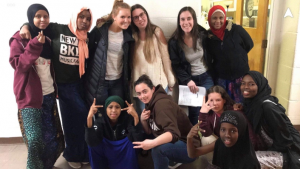By: Cayla Dorsey, ’20
Laughter fills the small library at Northside Learning Center. Snacks and laptops line the desks of a talkative group of middle school girls while Syracuse University students guide them through their lesson plan using graphical code. At the end of the session, the middle schoolers confidently present their progress to their fellow coders.
This is a typical Girls Who Code meeting for a group of driven Syracuse University female students who volunteer their time to make a difference in the Syracuse community. Working with Girls Who Code, the Syracuse University chapter aims to guide young girls in the Syracuse community toward careers in STEM.
 Girls Who Code is an international non-profit working to close the gender gap in the technology workforce. UNESCO data found only 30% of females choose STEM-related fields in higher education. The biggest participation drop-off in computer science for girls is between the ages of 13-17, which inspired Girls Who Code founder Reshma Saujani to tackle the issue. Since 2012,185,000 girls have been served through afterschool programs, summer camps and college loops.
Girls Who Code is an international non-profit working to close the gender gap in the technology workforce. UNESCO data found only 30% of females choose STEM-related fields in higher education. The biggest participation drop-off in computer science for girls is between the ages of 13-17, which inspired Girls Who Code founder Reshma Saujani to tackle the issue. Since 2012,185,000 girls have been served through afterschool programs, summer camps and college loops.
Information technology management major Emily Simens, ’20, and Arva Hassonjee, ’19, founded the Syracuse University chapter in 2017. The two began working with middle schoolers and high schoolers at the Northside Learning Center through the Office of Engagement Programs at Hendricks Chapel. Simens had formerly worked with Girls Who Code over the summer as a teaching assistant for the J.P. Morgan Chase Brooklyn chapter.
“When Arva and I decided to start the Girls Who Code chapter at Northside Learning Center, we saw a huge need for filling the gap for language learners in technology education,” Simens said.
Most of the students at Northside Learning Center are English language learners and might not always excel with regular teaching styles. Policy studies major Hanna Nichols, ’20, is the current lead instructor of the Girls Who Code chapter and is working to revamp the lesson plans to provide audio-visual alternatives for language learners that need more support.
“It’s been a great experience for me to get to know the girls I work with, while also developing my capstone thesis to work on what I’m passionate about,” Nichols said.
Nichols works with the national Girls Who Code leaders to help create a program that better benefits different types of students who might not have the same resources as other chapters. Recently, Hendricks Chapel donated five laptops to the Girls Who Code program to ensure that all of the girls in the program could work on a reliable computer independently.
“This work is very rewarding and has enhanced my experience at Syracuse University,” Nichols said. “I learn just as much from the girls as they learn from me.”
Currently, Simens and Nichols are working to help their high school students build a digital portfolio of work to use in their college applications, showcasing their technology skills. Middle school students will focus on building games through the graphical programming language Scratch.
Experiential learning also is an important component of Girls Who Code. The chapter is planning a field trip to Sidearm Sports and Digital Hyve in downtown Syracuse to expose students to opportunities that might interest them in the future.
Girls Who Code is interested in recruiting more student volunteers interested in creating more spaces for women in STEM careers. For further inquiry about joining the Syracuse University chapter, contact Hanna Nichols at hnichols@syr.edu. For other opportunities to volunteer within the Syracuse community, contact Syeisha Byrd, director of community engagement, at smbyrd@syr.edu.
